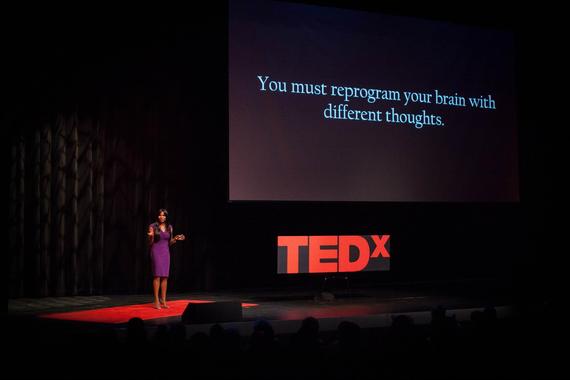"You are messy." "You are wrong." "You are bad." These are common statements made by teachers and parents. What is wrong with these words? The answer may shock you.
As a TED speaker of the talk "Reprogramming Your Brain to Overcome Fear," I was taken aback when watching fellow TED speaker Dr. Brene Brown share powerful information on OWN recently. Dr. Brene Brown states the same truth that I share in my book Mathaphobia. The OWN video title explains, "shame is the 'number one classroom-management tool' in our schools."
As an award-winning rocket scientist and TV personality who educates as a part-time math professor, I jumped for joy when Brene explained this important concept. Shame has been the number one tool used, and it has caused the number one educational fear. The initial statements -- "You are messy; you are wrong; you are bad"-- debilitates students and plants a severe fear into the brain that I have identified as Mathaphobia®.
Deposited into brains somewhere between third and 12th grade, mathaphobia is a mental, self-imposed fear, causing the inability to deal comfortably with numbers, chance and cause-and-effect relationships. In short, when a person has mathaphobia, he exhibits dysfunctional actions when attempting to solve problems in real life, and in the classroom. Students who embed this fear transform into "Quincy the Quitter," "Donna the Over-Doer," "Samuel the Struggler" and "Crystal the Criticizer."
After 20 years of helping students, I discovered the three main mathaphobia sources: parents, teachers and school systems. Through selective comments and actions, parents and teachers unknowingly promote fear within learning. Consequently, mathaphobia dominates a person's thinking, shutting off frontal brain lobe activity. And these lobes are required in all problem-solving. In daily life, as in STEM fields, the frontal brain lobes are needed in finding solutions.
Although I have professional success now, I was not immune to classroom shame and fear. When I was in fourth grade, I experienced a teacher who penalized students for making mistakes. I call her "Mrs. Subtraction." When we made a mistake, Mrs. Subtraction said, "You are wrong." And if we made any mistake, we were "bad." As a result, I dreaded attending class and arriving on time. Years following, I falsely thought perfection achieved "goodness." This fear presented itself as a mathaphobia® character I call "Donna the Over-Doer." I overdid, over-achieved, and wore myself into the ground trying to prove my self-worth until I became aware of these actions.
Some teachers inadvertently shame students by making three huge mistakes. They describe students negatively, imply that some questions are dumb, and make students feel bad if a previous concept is misunderstood. When teachers use statements like "You are ....," a student falsely defines themselves as the description. For example, a student translates "You are bad..." into thinking "I am bad." A student translates "You are messy" into never achieving a clear-mind. Many teachers are unaware that these statements impact brain function. However, I share three easy strategies to help refocus the teaching communication before fear has a chance to spread.
1. Focus on the product, not the person.
When I worked in a NASA team launching 28 Space Shuttle missions into Space, we did not have time to focus on feelings. The focus was redirected to the product. Here we learned to focus on corrective actions, so we could meet the important launch time-window. The mission was to launch the Space Shuttle and astronauts on-time and safely. This approach can apply to the classroom. Teachers have limited time. When correcting student actions, focus on the product, and not the person. By focusing on the product and outcome, the teaching mission is accomplished without distraction. To reprogram the brain for example, you can replace the focus in each of the following statements.
•"You are wrong," becomes "The answer is not correct yet."
•" You are messy," becomes "Next time, write the work so anyone can understand the solution."
•" You are bad," becomes "These actions can be improved by doing .....next time."
2. Decided no question is a dumb question.
In my TED Talk, I share that my high school math teacher helped me regain confidence in asking questions. Later in life, this skill helped me to become a top scientific researcher, gaining international recognition. Questioning is the most powerful skill in all scientific discovery. As an educator now, I hear the biggest student complaint: "That teacher did not want to answer my question." Too often, students feel intimidated by educators, because these teachers do not answer their curiosity. When considering a lecture schedule, sometimes there is no time for questions. However when considering how people learn effectively, the absence of questioning is the most detrimental aspect responsible for embedding fear. When maintaining a lecture schedule, you can take a few effective steps.
- Always say, "Every question is valid and important."
- After a student asks a question, say, "That is a good question."
- If someone has an elementary question, simply answer it, and move on.
Also when a student asks a question, chances are that five-to-six people have the exact same question, but others may be too shy to ask. Students need to feel empowered to become beginners again.
3. Apologize to a student.
Caution: this step is only for those individuals who are strong enough to lead. Recently, a fellow teacher lost his patience while helping a student during a class assignment. The teacher was annoyed that Billy "should have already known" the basic math principle. Instead of explaining the concept to Billy, the teacher said, "You should know how to do this already." The teacher left and went to other students asking for help. The next day, Billy demonstrated a negative learning attitude towards the teacher. Needing empowerment, the teacher sought my advice.
I told the teacher to apologize to the student. Shocked, the teacher questioned me. However, he took my recommendation and returned to the student saying, "The other day, I was short within helping you, and I apologize. Please allow me to answer your questions now."
Billy looked surprised, and he accepted the teacher's apology. In the following weeks, Billy worked more diligently and asked more questions, becoming more eager than before. Billy earned an A in the class. The teacher was happy. The student was happy. From my teaching experience, students have vulnerability issues in addition to their fear. If a teacher is willing to admit imperfection, the teacher becomes admired as a leader. Respect is granted. By stating corrective measures and adhering to them, a teacher leads in regenerating respect from everyone.
In my life, it took time to reprogram my brain for success. I, Olympia LePoint, devised strategies like these to become the mathaphobia® problem-solver I call "Sarah the Strategist." Take this information and create new ways for educational success.
For more information, watch these fascinating videos:
- TED video: http://www.OlympiaLePoint.com/TED.html




